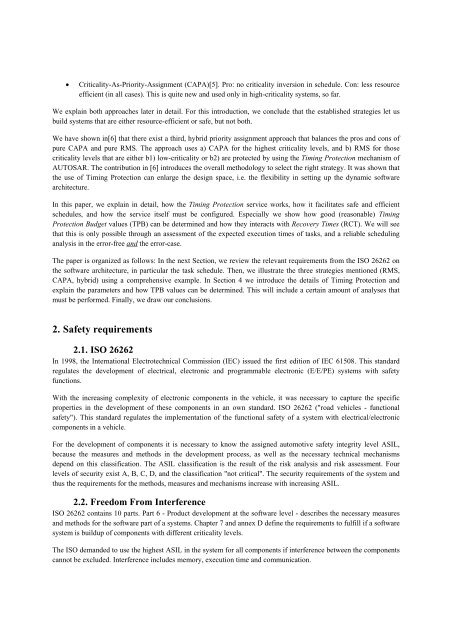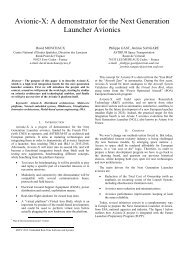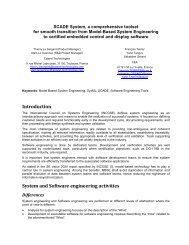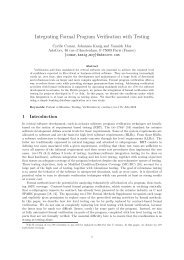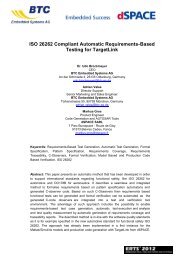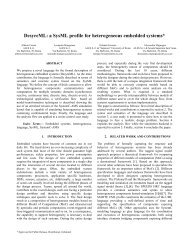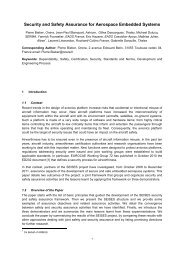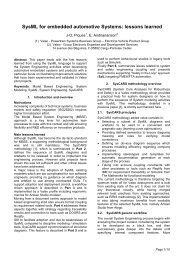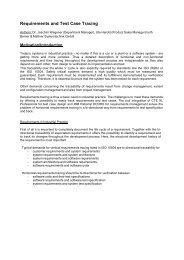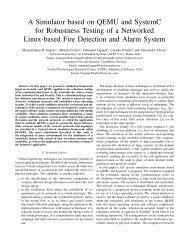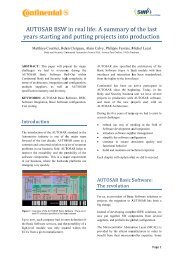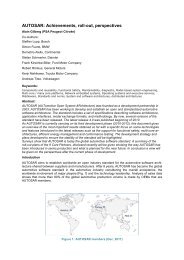Applying the AUTOSAR timing protection to build safe and efficient ...
Applying the AUTOSAR timing protection to build safe and efficient ...
Applying the AUTOSAR timing protection to build safe and efficient ...
You also want an ePaper? Increase the reach of your titles
YUMPU automatically turns print PDFs into web optimized ePapers that Google loves.
Criticality-As-Priority-Assignment (CAPA)[5]. Pro: no criticality inversion in schedule. Con: less resource<br />
<strong>efficient</strong> (in all cases). This is quite new <strong>and</strong> used only in high-criticality systems, so far.<br />
We explain both approaches later in detail. For this introduction, we conclude that <strong>the</strong> established strategies let us<br />
<strong>build</strong> systems that are ei<strong>the</strong>r resource-<strong>efficient</strong> or <strong>safe</strong>, but not both.<br />
We have shown in[6] that <strong>the</strong>re exist a third, hybrid priority assignment approach that balances <strong>the</strong> pros <strong>and</strong> cons of<br />
pure CAPA <strong>and</strong> pure RMS. The approach uses a) CAPA for <strong>the</strong> highest criticality levels, <strong>and</strong> b) RMS for those<br />
criticality levels that are ei<strong>the</strong>r b1) low-criticality or b2) are protected by using <strong>the</strong> Timing Protection mechanism of<br />
<strong>AUTOSAR</strong>. The contribution in [6] introduces <strong>the</strong> overall methodology <strong>to</strong> select <strong>the</strong> right strategy. It was shown that<br />
<strong>the</strong> use of Timing Protection can enlarge <strong>the</strong> design space, i.e. <strong>the</strong> flexibility in setting up <strong>the</strong> dynamic software<br />
architecture.<br />
In this paper, we explain in detail, how <strong>the</strong> Timing Protection service works, how it facilitates <strong>safe</strong> <strong>and</strong> <strong>efficient</strong><br />
schedules, <strong>and</strong> how <strong>the</strong> service itself must be configured. Especially we show how good (reasonable) Timing<br />
Protection Budget values (TPB) can be determined <strong>and</strong> how <strong>the</strong>y interacts with Recovery Times (RCT). We will see<br />
that this is only possible through an assessment of <strong>the</strong> expected execution times of tasks, <strong>and</strong> a reliable scheduling<br />
analysis in <strong>the</strong> error-free <strong>and</strong> <strong>the</strong> error-case.<br />
The paper is organized as follows: In <strong>the</strong> next Section, we review <strong>the</strong> relevant requirements from <strong>the</strong> ISO 26262 on<br />
<strong>the</strong> software architecture, in particular <strong>the</strong> task schedule. Then, we illustrate <strong>the</strong> three strategies mentioned (RMS,<br />
CAPA, hybrid) using a comprehensive example. In Section 4 we introduce <strong>the</strong> details of Timing Protection <strong>and</strong><br />
explain <strong>the</strong> parameters <strong>and</strong> how TPB values can be determined. This will include a certain amount of analyses that<br />
must be performed. Finally, we draw our conclusions.<br />
2. Safety requirements<br />
2.1. ISO 26262<br />
In 1998, <strong>the</strong> International Electrotechnical Commission (IEC) issued <strong>the</strong> first edition of IEC 61508. This st<strong>and</strong>ard<br />
regulates <strong>the</strong> development of electrical, electronic <strong>and</strong> programmable electronic (E/E/PE) systems with <strong>safe</strong>ty<br />
functions.<br />
With <strong>the</strong> increasing complexity of electronic components in <strong>the</strong> vehicle, it was necessary <strong>to</strong> capture <strong>the</strong> specific<br />
properties in <strong>the</strong> development of <strong>the</strong>se components in an own st<strong>and</strong>ard. ISO 26262 ("road vehicles - functional<br />
<strong>safe</strong>ty"). This st<strong>and</strong>ard regulates <strong>the</strong> implementation of <strong>the</strong> functional <strong>safe</strong>ty of a system with electrical/electronic<br />
components in a vehicle.<br />
For <strong>the</strong> development of components it is necessary <strong>to</strong> know <strong>the</strong> assigned au<strong>to</strong>motive <strong>safe</strong>ty integrity level ASIL,<br />
because <strong>the</strong> measures <strong>and</strong> methods in <strong>the</strong> development process, as well as <strong>the</strong> necessary technical mechanisms<br />
depend on this classification. The ASIL classification is <strong>the</strong> result of <strong>the</strong> risk analysis <strong>and</strong> risk assessment. Four<br />
levels of security exist A, B, C, D, <strong>and</strong> <strong>the</strong> classification "not critical". The security requirements of <strong>the</strong> system <strong>and</strong><br />
thus <strong>the</strong> requirements for <strong>the</strong> methods, measures <strong>and</strong> mechanisms increase with increasing ASIL.<br />
2.2. Freedom From Interference<br />
ISO 26262 contains 10 parts. Part 6 - Product development at <strong>the</strong> software level - describes <strong>the</strong> necessary measures<br />
<strong>and</strong> methods for <strong>the</strong> software part of a systems. Chapter 7 <strong>and</strong> annex D define <strong>the</strong> requirements <strong>to</strong> fulfill if a software<br />
system is <strong>build</strong>up of components with different criticality levels.<br />
The ISO dem<strong>and</strong>ed <strong>to</strong> use <strong>the</strong> highest ASIL in <strong>the</strong> system for all components if interference between <strong>the</strong> components<br />
cannot be excluded. Interference includes memory, execution time <strong>and</strong> communication.


